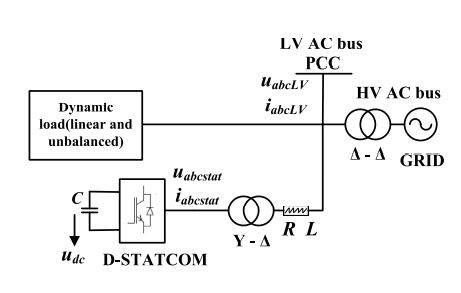Analysis of Fractional Order Sliding Mode Control in a D-STATCOM Integrated Power Distribution System
Also Available Domains Distribution Systems
Objective
The main objective of this project is to reduce total harmonic distortion (THD) and voltage unbalance factor (VUF) of the grid voltage due to disturbances like the voltage fluctuations.
Abstract
At present, the disturbances like the voltage fluctuations, resulting from the grid’s complexities and unbalanced load conditions, create severe power quality concerns like total harmonic distortion (THD) and voltage unbalance factor (VUF) of the grid voltage. Though the custom power devices such as distribution-static compensators (D-STATCOMs) improve these power quality concerns, however, the accompanying controller plays the substantial role. Therefore, this paper proposes a fractional-order sliding mode control (FOSMC) for a D-STATCOM to compensate the low power distribution system by injecting/absorbing a specific extent of the reactive power under disturbances. FOSMC is a non-linear robust control in which the sliding surface is designed by using the Riemann-Liouville (RL) function and the chattering phenomenon is minimized by using the exponential reaching law.
The stability of FOSMC is evidenced by employing the Lyapunov stability criteria. Moreover, the performance of the proposed FOSMC is further accessed while doing its parametric variations. The complete system is demonstrated with a model of 400V, 180kVA radial distributor along with D-STATCOM under two test scenarios in MATLAB/Simulink environment. The results of the proposed controller are compared with the fixed frequency sliding mode control (FFSMC) and conventional proportional-integral (PI) control. The results validate the superiority of the proposed controller in terms of rapid tracking, fast convergence, and overall damping with very low THD and VUF.
INDEX TERMS -Power quality, custom power devices, distribution static compensator, fractional order sliding mode control, total harmonic distortion, voltage unbalance factor.
NOTE: Without the concern of our team, please don't submit to the college. This Abstract varies based on student requirements.
Block Diagram

Specifications
Software Configuration:
Operating System : Windows 7/8/10
Application Software : Matlab/Simulink
Hardware Configuration:
RAM : 8 GB
Processor : I3 / I5(Mostly prefer)
Learning Outcomes
- Introduction to Matlab/Simulink
- What is EISPACK & LINPACK
- How to start with MATLAB
- About Matlab language
- About tools & libraries
- Application of Matlab/Simulink
- About Matlab desktop
- Features of Matlab/Simulink
- Basics on Matlab/Simulink
- Introduction to controllers.
- Study of PWM techniques.
- Project Development Skills:
- Problem analyzing skills
- Problem solving skills
- Creativity and imaginary skills
- Programming skills
- Deployment
- Testing skills
- Debugging skills
- Project presentation skills
- Thesis writing skills


 Paper Publishing
Paper Publishing
